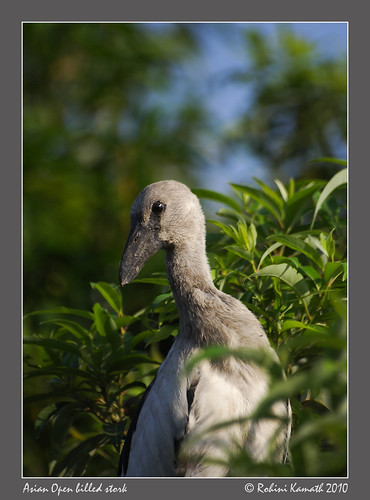The park consists of little islands on the banks of the river Cauvery, and is near Srirangapatna town.
Some history that I became aware of only recently - the islands were artificially created when a dam across the Cauvery was built in the 1700s. It was ornithologist Dr. Salim Ali who persuaded the Wodeyar royal family of Mysore to convert the area to a bird sanctuary in the 1940s.
If you time your visit to the sanctuary in the nesting season, you will be treated to quite a sight ( if you can tolerate the pungent odor of bird droppings )
The birds are seen from boats ( human powered with oars ) or by walking along the banks or from a watch tower. The park also has gardens, lawns and artificial ponds which host other little birds.

Black headed Ibis (Threskiornis melanocephalus)
Being large birds, these are usually the first to be seen from the boat ride.
These birds breed in South Asia and Southeast Asia from Pakistan to India, Sri Lanka east up to Japan. They build a nest of twigs and lay 2 to 4 eggs.
They feed on fish, frogs and other water creatures, as well as on insects.
Spot Billed Pelican (Pelecanus philippensis)
They breed in southern Asia from southern Pakistan across India east to Indonesia. They can be identified at close range by the spots on the upper mandible. It is a colonial breeder, often breeding in the company of other waterbirds. The birds nest in gregarious colonies and the nest is a thick platform of twigs placed on a low tree. Breeding season from October to May.
Painted Stork (Mycteria leucocephala)
This is a very large wading bird. Its range extends from wetlands and plains of tropical Asia south of the Himalayas in South Asia to Southeast Asia. Being very colorful birds, identifying them couldn't be simpler. Their distinctive pink feathers near the tail give them their name.
Regrettably I always have very poor luck with these birds, I never seem to be able to capture them photogenically. I'm not happy with my photos of it, so I'm including one of Keshav's as well.

They forage in flocks in shallow waters along rivers or lakes. They immerse their half open beaks in water and sweep them from side to side and snap up their prey of small fish that are sensed by touch. As they wade along they also stir the water with their feet to flush hiding fish. They nest colonially in trees, often along with other waterbirds.
In northern India, the breeding season begins in mid-August while in southern India the nest initiation begins around October and continues till February - April.

Juvenile Asian Open Bill
Asian Open Billed Stork (Anastomus oscitans)
It is a resident breeder in tropical southern Asia from India and Sri Lanka east to Southeast Asia.
Graceful in flight, this a broad-winged soaring bird, which is not particularly attractive or photogenic at close quarters. It can be seen flying overhead with its neck outstretched. Not as large as the painted stork, it can be easily identified by its unusually shaped beak, which only meets at the tip, leaving a gap between the upper and lower mandibles. They breed near inland wetlands and build stick nest in trees, typically laying 2-6 eggs.
Breeding adults are all white except for the black wing flight feathers, red legs and dull yellow-grey bill.
Eurasian Spoon Bill (Common Spoonbill - Platalea leucorodia)
Breeds in southern Eurasia (Spain to Japan) and in North Africa. Most birds migrate to the tropics in winter, with European breeders mainly going to Africa, but a few remaining in mild winter areas of western Europe north to the United Kingdom.
The breeding bird is all white except for its dark legs, black bill with a yellow tip, and a yellow breast patch like a pelican. It has a crest in the breeding season. Non-breeders lack the crest and breast patch, and immature birds have a pale bill and black tips to the primary flight feathers. Unlike herons, spoonbills fly with their necks outstretched.
The Eurasian Spoonbill can be differentiated from the African Spoonbill by its crest. The African species also has a red face and legs which are absent here.

Purple Heron (Ardea purpurea)
This is among my personal favorites, since its not often seen and is painfully shy. It breeds in Africa, central and southern Europe, and southern and eastern Asia. The European populations are migratory, wintering in tropical Africa; the more northerly Asian populations also migrate further south within Asia.
It breeds in colonies in reed beds or trees close to large lakes or other extensive wetlands building a bulky stick nest. It feeds in shallow water, spearing fish, frogs, insects, small mammals, reptiles and small birds. When spotted, it will often be waiting motionless for prey, or slowly stalking its victim. It tends to keep within reed beds more than the Grey Heron and is therefore less often seen, despite its large size.
It has a slow flight, with its neck retracted. This is characteristic of herons and bitterns, and distinguishes them from storks, cranes and spoonbills, which extend their necks. The long neck of Purple Heron looks particularly snake-like, with more of an S-shape in flight. Its call is not melodious, a loud croaking "krek".
In the next parts of this series, I hope to cover :
Cattle Egret, Eurasian Thicknee, Kingfishers, River Tern, Blyth's Reed Warbler and the Streak-throated swallow





